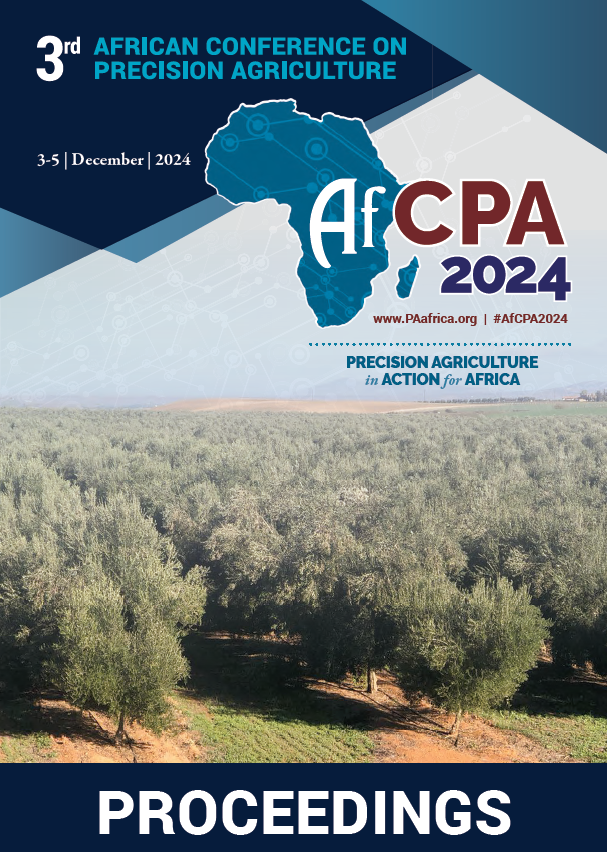Download the Conference Proceedings
Proceedings
Authors
| Filter results10 paper(s) found. |
|---|
1. Cashew Trees Detection and Yield Analysis using UAV-based MapIn this study we developed a novel method to detect cashew trees in an orthophoto map derived from images collected by an unmanned aerial vehicle (UAV). We also suggest a way in which these detections can be used to analyse the yield of the cashew farm. The proposed method uses images analysis to find the tops of trees, to merge different tops located on the same tree, and to segment individual tree. The segmented trees are used in a deep learning framework to know the exact location of cashew... T. Bayala, I. Ouattara, A. Visala, S. Malo |
2. Delineation of site-specific management zones based on soil apparent electrical conductivity (ECa) measurement combining traditional soil sampling methodSite-specific management requires the identification of treatment areas based on homogeneous characteristics. The designation of subfield regions is challenging because of complex correlations appearing in spatial variability of soil properties and nutrient concentrations. The research was conducted on two neighbouring fields (48 ha and 15 ha) in Fejér county, Hungary. Soil ECa mapping was carried out on 22 October, 2019 and soil samples were taken on 15 November, 2019.... I.M. Kulmany, V. Vona, M. Vona, L. Szekeres, L. Bede, G. Milics, B. Kovacs |
3. FARMER CHARLIE: PRECISION AGRICULTURE AT SMALLHOLDER FARMERS’ SERVICEPreliminary research and an ongoing project in Nigeria showed that agriculture is a crucial activity in the country. It is mainly carried out in small, family-owned farms: in fact, 88% of Nigeria farmers work on less than 0.5 ha. Lack of resources, of readily available information and the impact of climate on agricultural activities lead to low yields and high-cost farm inputs (FAO, 2020). The availability of agricultural data and weather forecast information could play an essential role in improving... B. Bonnardel, G. Cursoli |
4. Analysis, design and development of a web and mobile application for fertilizer olive orchards recommendationsFarmer’s fertilization practices (FFP) in olive intensive or super intensive orchards must be improved to a better control of fertilization costs, to increase olive yielding, to maintain soil fertility and to avoid environment pollution. Indeed, a large category of fertilizer users apply fertilizers arbitrary (66%) without any knowledge about the adequate nutrient requirements of a such planting system. To improve the FFP in intensive and super intensive olive orchards, and in the frame... A. Larbi, H. Boulal, H. El arbi, W. Ben hamouda |
5. Soil fertility characterization and mapping for Adigudem plain, Northern EthiopiaAs Ethiopia’s agriculture has been influenced by variability and poor soil fertility management and information, thus this study was aimed to determine the physico-chemical properties of soils and build geo-referenced soil information systems so as to have precision agriculture for adigudem plain. An area of 229 km2 comprising different villages was delineated for the study. Soil sampling points were arranged in a grid form and georeferenced using a hand-held GPS. A total of 194 Soil samples... G. Berhe |
6. Using Decision Support Tool for Site Specific Nutrient Management in Maize Production in Ethiopia: The case of Nutrient ExpertThere are huge variabilities among farmers in terms of crop management practices, soil types and fertility status as well as climatic conditions all of which affects crop fertilizer requirement and yield. Despite these variations, farmers are using blanket/regional fertilizer recommendations, which does not consider the above-mentioned variabilities. As a consequence, farmers are either practicing over fertilization or under fertilization, both of which have undesirable consequences. Therefore,... T. Balemi |
7. Precision Agriculture for Sustainable Transformation of Food Systems in Africa... A. Bouraqqadi |
8. Implementing Field-Based High Throughput Plant Phenotyping: The Open Source Way... Y. Kassim |
9. Sustainability of Maize Production with Farmers’ Practices and Redesigned Crop Management Practices in CRV and Jimma of EthiopiaMulti-criteria assessment of crop management practices is vital for sustainable crop production and environmental safety. In this study, sustainability of maize production with farmer’s practice (FP), redesigned plant density plus current fertilizer use (RDCF), current plant density plus redesigned fertilizer use (CDRF), and redesigned plant density and redesigned fertilizer use (RDRF) were assessed at farm level based on social, agronomic, economic and environmental principles in Central... W. Kenea, A.N. Woldekristos, T. Balemi |
10. Empower Farmers to Sustainably Agricultural Productivity in West Africa: FeSeRWAM, a Digital Advisor for FarmersMany smallholder farmers in West Africa have a common challenge which is their inability to access the right information on appropriate agricultural inputs and practices to unlock existing potential, make better decisions and get more dividends on their investments. Supported by USAID, Feed the Future "Enhancing Growth through Regional Agricultural Input Systems (EnGRAIS/IFDC) and Partnership for Agricultural Research, Education and Development (PAIRED) have developed and deployed an... J. Toviho, I.E. Brou, K. Kouassi |
